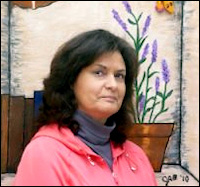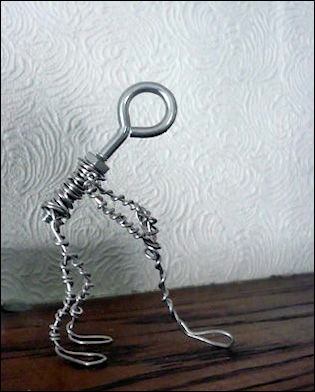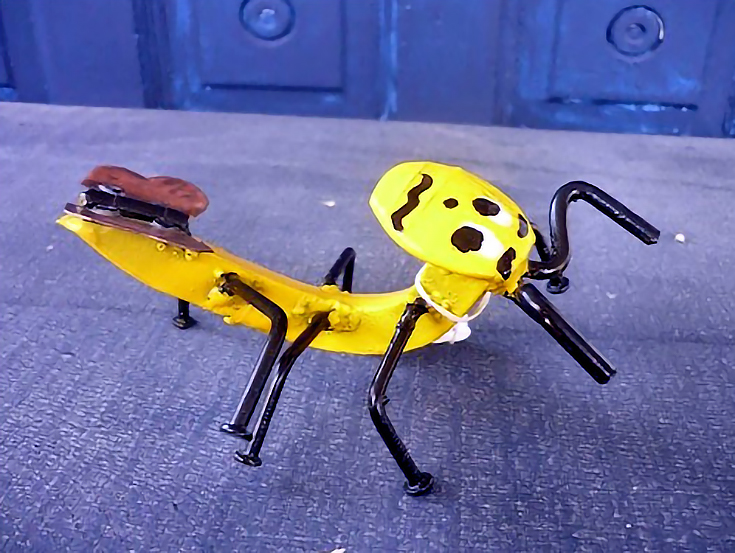
Today, Julie shares some quick tips on using found materials to “make art, not waste.”
Alyice: What prompted you to start creating the type of art you create today?
Julie: It was born out of necessity. It was a way to make ends meet.
My grandfather is a huge influence, though. He has made small tractors and sculptures out of old nuts, bolts washers, nails, and almost any other old tool you could imagine. And for years, he made “yard birds” out of unwanted shovels, bicycle parts, old tools and various nuts and bolts.
Alyice: How did you find your artistic voice?
Julie: I’m not sure I have found it. I feel it is still evolving. But taking a discarded piece of wire or metal and turning it into a beautiful piece of art is great form of expression.
I am at ease and happiest when I paint or sculpt. I feel a need to paint or bend wire and metal every day. It lets me express my quirkiness.
If I am away from home, I am always thinking of new projects. I write down ideas so I won’t forget them. I have notebooks in the car and scraps of paper with notes, ideas and scribbled sketches on them. I learned to start carrying a camera and sketch book with me. You never know when you’ll find that next inspiration.
Alyice: On your website, you state, “Our goal is to promote human consciousness in the marketplace by using salvaged, recycled, repurposed items and natural products”. Can you tell us a little bit more about your philosophy on this?
Julie: Buying handmade, homemade, or recycled products keeps unwanted items out of landfills. Using unwanted lumber for bird or butterfly houses saves trees which in turn helps the environment. An unused shovel, wrench, or scrap of metal can be turned into a beautiful sculpture for a yard or garden. Also, metal never really dies. It can be recycled over and over again.
Our soap, as well as our candles, however, are not made from anything recycled and have no added chemicals; therefore they are as natural as possible. Handcrafted soap has excellent skin care properties. Using natural soy in our candles, for instance, is not only healthier than paraffin (a petroleum by product) wax but helps the American farmer prosper. Both our candles and our soap are made from ingredients made in America, therefore, buying handmade products can also help the economy.
Alyice: So would you say that your company is a “Green company”? How does being more environmentally conscious help both your business and your customers?
Julie: Yes, I feel we are a green company. Or at least as green as we can be. We are concerned about the environmental impact the excessive deforestation of the planet. Using recycled materials reduces energy consumption and pollution. A clean planet benefits everyone.
Alyice: You sell everything from handcrafted soaps and hand poured soy candles to hand carved wood and gourds to paintings. How are you able to brand your art business with such a vast array of products?
Julie: It was very difficult. We are still not sure we chose the correct name for the business but in the end, we feel that doing one thing only results in burnout. Having a wide range of interests makes me feel whole as an artist.
Alyice: With so many of your materials coming from found objects, how did you come up with a profitable pricing structure when it comes to your handcrafted goods?
Julie: The tough economy, of this area, has a lot to do with the pricing. Being homebased and having low overhead is great, though.
My soap and candles are made from premium supplies. They have the same ingredients as the soap found in health food stores. And though I feel my pricing is a bit low, I sell a lot of it locally and am able to still make a nice profit.
As for the metal art sculptures, we researched the price of other metal art sculptures and took that into consideration… along with the time, cost and skill it takes to make each piece.
Putting a price on art is difficult. Each piece is unique, no two are alike. And therefore, time and supplies vary. It can take days, weeks, or months to complete a project.
Alyice: Where do you look for materials to upcycle and recycle in your art?
Julie: While we don’t have acres of junk piled around, we do have a lot of materials we’ve accumulated over the years.
Most of the parts are small and are tucked away in boxes or buckets. Quite often we have people drop off items they feel we can use. Other times they want a sculpture made from something they no longer use, so they’ll bring that item into the shop.
We are in a small town farming community and often old barns or farm houses are being torn down which is a great opportunity to grab barn boards for bird houses and butterfly houses. Often these items can be acquired at no cost.
The old door hinges from old farm houses, for instance, can’t be bought at the hardware stores these days. Yet, if you can get a hold of some and add some copper wings, you have a beautiful metal butterfly.
As far as the gourds, we usually grow them ourselves but have purchased them at farmer’s markets. Flea markets and garage sales are a great place to find old unique wrenches and tools.

Alyice: What tips can you share when it comes to using found and previously owned objects in one’s art?
Julie: Don’t just throw unused parts in the trash, recycle whenever possible. And make sure you have plenty of room to store the found materials until you are ready to use them.
Alyice: Let’s end with this. What’s the coolest recycling tip you’ve ever received?
Julie: I would have to say, (1) using left over wax, pieces of candle wick and saw dust to make fire starters for camping and backpacking. And (2), make art, not waste!
To see more of Julie’s recycled and salvaged art, please visit salvagedstyle.com.
This post may contain affiliate links.


